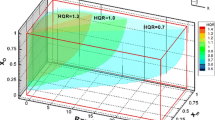Abstract
An experimental apparatus has been built to measure the flammability limits of combustible gases based on Chinese national standard GB/T 12474-90. The flammability limits of four binary mixtures of R161/R134a, R152a/R134a, R161/N2 and R152a/N2 were measured with this apparatus at atmospheric pressure and ambient temperature. The fuel inertization points (FIP) of these mixtures can be found from the envelopes. Comparisons were made with the literature data; good agreement for most measurements was obtained. R134a was found to have a better dilution effect than nitrogen in reducing the flammability of hydrofluorocarbons.
Similar content being viewed by others
References
Coward H. F., and Jones G. W., “Limits of flammability of gases and vapors,” US Bureau of Mines, Bulletin No. 503, 1952.
DIN 51649, Teil 1, “Bestimmung der Explosionsgrenzen von Gases und Gasgemischen in Luft,” Deutsches Institut für Normung, Berlin, 1986.
ASHRAE Standard 34, “Number designation and safety classification of refrigerants,” American Society of Heating Refrigerating and Air-conditioning Engineers, Atlanta, Georgia, 1989.
ASTM E681, “Standard test method or concentration limits of flammability of chemicals,” American Society for Testing and Materials, Philadelphia, 1994.
prEN1839, “Determination of explosion limits of gases vapours and their mixtures,” European Standard, 1995.
Takahashi A., Urano Y., Tokuhashi K., Nagai H., Kaise M., and Kondo S., “Fusing ignition of various metal wires for explosion limits measurement of methane/air mixture”, Journal of Loss Prevention in the Process Industries, vol. 11, 1998, pp. 353–360.
Takahashi A., Urano Y., Tokuhashi K., and Kondo S., “Effect of vessel size and shape on experimental flammability limits of gases,” Journal of Hazardous Materials, vol. 105, 2003, pp. 27–37.
Zabetakis M. G., “Flammability characteristics of combustible gases and vapors,” US Bureau of Mines, Bulletin 627, 1965.
NFPA, “Guide to fire hazard properties of flammability liquids, gases, and volatile solids,” Quincy, MA, 325M: National Fire Protection Association, 2002.
Kondo S., Takizawa K., Takahashi A., and Tokuhashi K., “Extended Le Chatelier’s formula and nitrogen dilution effect on the flammability limits,” Fire Safety Journal, vol. 41, 2006, pp. 406–417.
Kondo S., Takizawa K., Takahashi A., and Tokuhashi K., “Extended Le Chatelier’s formula for carbon dioxide dilution effect on flammability limits,” Journal of Hazardous Materials, vol. 138, 2006, pp. 1–8.
Yang Z., Liu B., and Zhao H. B., “Experimental study of the inert effect of R134a and R227ea on explosion limits of the flammable refrigerants,” Experimental Thermal and Fluid Science, vol. 28, 2004, pp. 557–563.
Kondo S., Takizawa K., Takahashi A., Tokuhashi K., and Sekiya A., “Flammability limits of five selected compounds each mixed with HFC-125,” Fire safety Journal, vol. 44, 2009, pp.192–197.
Xuan Y. M., and Chen G. M., “Experimental study on HFC-161 mixture as an alternative refrigerant to R502,” International Journal of Refrigeration, vol. 28, 2005, pp. 436–441.
Wu J. F., Gong M. Q., and Zhang Y., “A mixed refrigerant, whose preparation and application,” Chinese Patent: 200810094555.1, 2008.
Chinese National Standard, “Method of test for explosion limits of combustible gases in air,” GB/T 12474-90, 1991.
Dietlen S., Hieronymus H., Plewinsky B., Schroder V., and Steen H., “Explosion behavior of the “non-flammable” CFC substitute 1,1,1,2-tetrafluoroethane (R134a),” Chemical Engineering and Processing, vol. 34, 1995, pp. 141–149.
Richard R. G., and Shankland I. R., “Flammability of alternative refrigerants,” ASHRAE Journal, vol. 34, 1992, pp. 20–25.
Author information
Authors and Affiliations
Rights and permissions
About this article
Cite this article
Li, Z., Gong, M., Wu, J. et al. Comparison of dilution effects of R134a and nitrogen on flammable hydrofluorocarbons. J. Therm. Sci. 18, 377–381 (2009). https://doi.org/10.1007/s11630-009-0377-x
Received:
Published:
Issue Date:
DOI: https://doi.org/10.1007/s11630-009-0377-x




